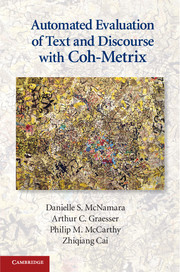Book contents
- Frontmatter
- Dedication
- Contents
- List of Figures
- List of Tables
- Acknowledgments
- Introduction
- Part I Coh-Metrix
- 1 What Is Text and Why Analyze It?
- 2 The Importance of Text Cohesion
- 3 The Science and Technology That Led to Coh-Metrix
- 4 Coh-Metrix Measures
- 5 Coh-Metrix Measures of Text Readability and Easability
- 6 Using Coh-Metrix Measures
- Part II A Beginner’s Guide to Writing Coh-Metrix Research
- Concluding Remarks
- References
- Appendix A Coh-Metrix 3.0 Indices
- Appendix B Coh-Metrix Indices Norms
- Index
2 - The Importance of Text Cohesion
Published online by Cambridge University Press: 05 June 2014
- Frontmatter
- Dedication
- Contents
- List of Figures
- List of Tables
- Acknowledgments
- Introduction
- Part I Coh-Metrix
- 1 What Is Text and Why Analyze It?
- 2 The Importance of Text Cohesion
- 3 The Science and Technology That Led to Coh-Metrix
- 4 Coh-Metrix Measures
- 5 Coh-Metrix Measures of Text Readability and Easability
- 6 Using Coh-Metrix Measures
- Part II A Beginner’s Guide to Writing Coh-Metrix Research
- Concluding Remarks
- References
- Appendix A Coh-Metrix 3.0 Indices
- Appendix B Coh-Metrix Indices Norms
- Index
Summary
The need to better understand the important role of cohesion in comprehension was the primary inspiration to develop Coh-Metrix (hence the “Coh” in Coh-Metrix). There has been considerable evidence that cohesion critically determines both how challenging a text is and how well the reader will understand it. Decades of research have demonstrated the importance of cohesion to text comprehension, yet at the turn of this century there were no means available for objectively measuring the cohesion of a text. Studies that had manipulated cohesion (or coherence as it has also often been referred to) had used guidelines to increase or decrease cohesion for any given text version, but there existed no measures of text cohesion itself, particularly measures that could be calculated at large scales (i.e., automatically). This situation presented a clear need to provide researchers and educators with a tool to objectively measure cohesion.
As we discussed in Chapter 1, one purpose of Coh-Metrix is to assess the characteristics of the text so that readers’ comprehension can be estimated for that particular text. Notably, however, Coh-Metrix provides estimates of the linguistic, semantic, and discourse characteristics of the text without taking into consideration such fundamental factors as the reader and the task. Any predictions based on Coh-Metrix values for a text should therefore be qualified by the multiple real-world factors that surround the text, including the reader and the task. Readers have varying abilities, knowledge, motivation, and purposes for reading. Tasks vary from reading under duress to reading to enjoy, to learn, and to solve problems. All of these factors potentially interact with the features of the text. A text feature may have one effect in one situation and an entirely different effect in another situation. Such interactions need to be considered carefully when interpreting Coh-Metrix output.
Information
- Type
- Chapter
- Information
- Publisher: Cambridge University PressPrint publication year: 2014
